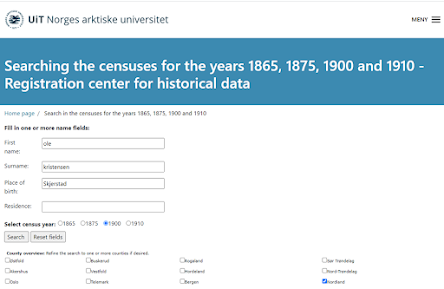
5 Resources & Tips
It is impossible to understand the origin of Norwegian ancestors without visualizing the geography and the map of counties, municipalities, and parishes. For example, the Diocese of Sør-Hålogaland is divided into eight deaneries. These deaneries are subdivided into municipalities. And, municipalities are further divided into parishes. Will talk about the farms later, but what about the defunct villages of our ancestors.
For this research project we covered the Salten Prosti and the Bodø Domprosti deaneries! We ran into the same issues as we scoured the municpalities: Dissolved Villages. In looking for Nordal Lakså because client wanted to visit, (their ancestors being from Skjerstad), we quickly learned that in 1905 Skjerstad was divided with Fauske and by 2005 Skjerstad was dissolved or shall I say "melded" into Bodø municiaplity. Nordal Lakså is defunct. Sometimes, though we just want to walk the land of our ancestors.
2. Confusion of Family names - Not always patronymic
Figure 2 See full article on Newspapers.comhttps://www.newspapers.com/image/571510007/?terms=patronymic%20norway&match=1
 |
| 1900 Norway Census Dad, Mom and Son with 3 distinct surnames |
Family names did not really exist in Norway until the 1900s. The traditional Norwegian naming practice is to use patronyms. In the 1801 and 1865 censuses people were noted by 1) their Christian name followed by 2) the patronymic and 3) the farm name. When a surname law was enacted in 1923 demanding all persons in a (core) family should have the same family name s the father/husband (head of household) in the family, the surname issue became a genealogists nightmare. Between abt. 1890 -1920 people gradually adopted family names. Some families took a patronymic name from their own patronymic name or that of their father or that of their husband. Others used the farm name. Well at least you would know their origin from the farm name. But all of this most often resulted in adult siblings having different surnames (some from the farm, some from their patronymic name).
 |
The Capital Times, Madison, Wisconsin, 18 Sep 1938, Page 4, newspapers.com |
Tip: We use the dokumentasjons-prosjektet website to fish through the plethora of spellings of farm names, and for comprehensive lists. Not to be confused with Os village in Bodø , but did you know there was so many variations for Os Farm in Fauske? Os. Oos, Ous, Aas, Ooss
 |
4. Step
Away from Ancestry
When it come to Norway research, we peruse ancestry.com, we embrace myheritage.com, and we soak up and ferret the Norwegian online archives and scans. Take a look at the three comparisons below: 1) ancestry 2) myheritage 3) UiT Norges arktiske universitet
Ancestry.com: Names and birthyear; no details
MyHeritage: The same as ancestry.com. However, myheritage does have a larger Norwegian collection of scanned documents. .
 |
Used link above with subscription
Often we get abbreviations on occupation rendering a translation engine useless. Should this happen go to the FamilySearch website for Norway Occupations to decipher the abbreviations. 5. Parish Registry Arkivverket Digitalarkivet The National Archives of Norway Digital Archives has a scanned archives of Paris registry and Census records. With google translate, a list of genealogical Norwegian words and the "English" button on the website, all researchers can wade through the Parish Records and scripted cursive. Here we uncovered the 1887 marriage of our subject; Ole Kristensen, and his death records. However, there is an 80 year rule that prohibited us from retrieving the death record for his wife. Summary This family was traced back to early 1700’s. What fun! For each generation we 1)
mapped and learned the geography 2) followed the family trail of names 3) became familiar
with the farms and parishes 4) scoured the Norwegian online scanned archives for
occupations/family names 5) used digital archives for church records… Write up
and repeat for next generation! Kathleen Brandt Be Historically Correct a3genealogy.com Accurate Accessible Answers a3genealogy@gmail.com |









No comments:
Post a Comment